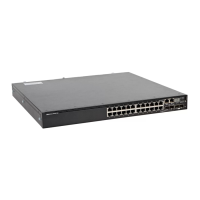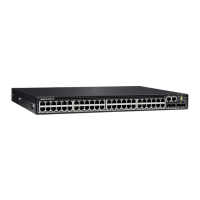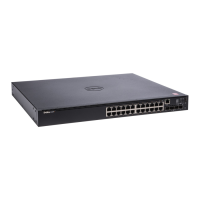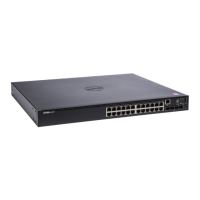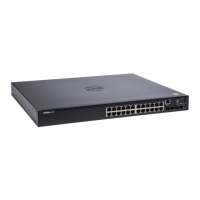724 Configuring the Spanning Tree Protocol
BPDU Protection
When the switch is used as an access layer device, most ports function as edge
ports that connect to a device such as a desktop computer or file server. The
port has a single, direct connection and is configured as an edge port to
implement the fast transition to a forwarding state. When the port receives a
BPDU packet, the system sets it to non-edge port and recalculates the
spanning tree, which causes network topology flapping. In normal cases, these
ports do not receive any BPDU packets. However, someone may forge BPDU
to maliciously attack the switch and cause network flapping.
BPDU protection can be enabled in RSTP to prevent such attacks. When
BPDU protection is enabled, the switch disables an edge port that has
received BPDU and notifies the network manager about it.
RSTP-PV
Dell Networking switches support both Rapid Spanning Tree Per VLAN
(RSTP-PV) and Spanning Tree Per VLAN (STP-PV) with a high degree of
interoperability with other vendor implementations, such as Cisco's PVST+
and RPVST+. RSTP-PV is the IEEE 802.1w (RSTP) standard implemented
per VLAN. A single instance of rapid spanning tree (RSTP) runs on each
configured VLAN. Each RSTP instance on a VLAN has a root switch. The
RSTP-PV protocol state machine, port roles, port states, and timers are
similar to those defined for RSTP. RSTP-PV embeds the DRC and
IndirectLink Fast Rapid Convergence (IRC) features, which cannot be
disabled.
STP-PV is the IEEE 802.1s (STP) standard implemented per VLAN. The
STP-PV-related state machine, roles, and timers are similar to those defined
for STP. STP-PV does not have the DirectLink Rapid Convergence (DRC) or
IndirectLink Rapid Convergence (IRC) features enabled by default. These
features can be enabled by the switch administrator.
NOTE: Loop Guard should be configured only on non-designated ports. These
include ports in alternate or backup roles. Root ports and designated ports
should not have loop guard enabled so that they can forward traffic.

